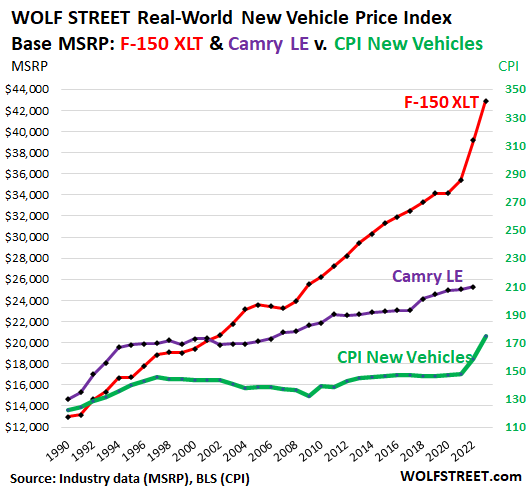By Wolf Richter for WOLF STREET.
The WOLF STREET “F-150 & Camry Price Index” tracks the Manufacturer’s Suggested Retail Price (MSRP) of the best-selling truck and of the best-selling car over the decades, and compares those prices to the government’s inflation index for new vehicles. The latest update for the 2025 model year is here.
The “F-150 & Camry Price Index” tracks the base versions of the Ford F-150 XLT and the Toyota Camry LE, no add-ons and without destination and delivery charges.
From the 1990 to the 2023 model year:
- MSRP of F-150 XLT: +231%
- MSRP of Camry LE: +77%
- CPI for new vehicles: +43%, including the 18% increase over the past 24 month.

Depending on market conditions, there are usually discounts and incentives and rebates, and practically no one pays MSRP, but this has nearly always been the case, and so it doesn’t change the trend. The exception were during the 2021 and 2022 vehicle shortage when many buyers paid over sticker for certain models, including many F-150s.
The thing called “hedonic quality adjustments.”
A big part of the difference between actual price increases in dollars and the CPI for new vehicles is a device called “hedonic quality adjustments.” The Bureau of Labor Statistics has applied them with increasing aggressiveness since the 1990s, as you can see in the chart above.
Price increases consist of at least two factors:
- The loss of purchasing power of the dollar (inflation, a monetary phenomenon)
- The costs of quality improvements, for example going from a 3-speed automatic transmission to a 10-speed electronically controlled transmission.
To isolate the loss of purchasing power of the dollar from the costs of quality improvements, the Bureau of Labor Statistics removes the estimated costs of those quality improvements and calls that process “hedonic quality adjustments.”
This process has suppressed the CPI for new vehicles over the past 25 years, even as actual prices in dollars of new vehicles have soared.
People are having to pay the actual prices in dollars – in their devalued dollars – and those prices have moved out of reach for many Americans, who’re now locked out of the new vehicle market, and can only buy used vehicles.
